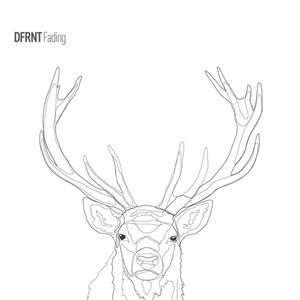DFRNT Fading
It’s not a coincidence that Alex Cowles’ label is called Echodub. The Edinburgh-based imprint professes […]

It’s not a coincidence that Alex Cowles’ label is called Echodub. The Edinburgh-based imprint professes a keen interest in “that deep, pulsating groove, that dubbed-out flow” on its Soundcloud page, and Fading, Cowles’ debut LP as DFRNT, remains faithful to that aesthetic straight through its 11 tracks, coating them in mellow, sultry moods, velvety-smooth synth lines, and the hulking rumble of sub-bass the same way an artisan chef might slather dark chocolate onto a layer cake.
As it turns out, the high degree of stylistic uniformity between DFRNT and his Echodub label is apparent on Fading in several different ways, from the production of the record to its visual presentation. Cowles assumed a high degree of creative control by crafting the album himself, releasing it on his own label, and designing all the artwork for the record, not to mention the websites for both Echodub and DFRNT. His visual aesthetic is stark, clean, and simple, often drawing upon awe-inspiring natural imagery, such as the chiseled landscape on the artwork for his 2010 single “Weapon.”
When it comes to DFRNT’s music, the same kind of consistency can be expected, particularly on Fading. Beginning with album opener “Silent Witness,” the LP draws its mood from a smooth and rich palette of sounds. There’s crackling ambient noise, the creak and sigh of a bus pulling to a stop, and a series of low-lying extended synth chords that eventually and patiently build into a slinky beat shrouded in sensuous melodies. When he uses vocal samples on tracks like “That’s Interesting” or “In You Go,” they are cast into the shade of silky reverb, where they can saturate the other sonic elements. On the dub-tinged “Incubus,” the sampled voice seems to float around the track, dodging between the booming bass notes, twinkling synth tones, and shuffling hi-hats.
There’s a sense of lavish serenity and smoldering sensuality throughout Fading. Each song is as voluptuous as the next, but this stability is also at the root of the album’s only drawback: it drags a bit during certain moments. The 11-minute “Prism” marks the LP’s halfway point, its static mood presenting the most trying aspect of Fading as a whole. Simply put, it takes a lot of patience to stick with “Prism” as it unfolds into a full, head-nodding groove that’s designed to appeal to the mind as much as the body. In and of itself, that’s not a problem at all, but when the song comes buried in a batch of other lengthy tunes channeling a similar sort of atmosphere, it requires some extra endurance.
That being said, it’s worth stating that DFRNT generally nails the mood and atmosphere that he seeks to create. The squawking, hornlike synth buried among the viscous synth pads on “Everyone Is Moving” gives the song several different textures at once, and the cumulative result is a track that flows like molten metal. Over the course of Fading, DFRNT slowly moves from more techno-inspired sounds, like the hooting, more angular synths on “El Spirito,” to bassier territory, as evidenced by the loud drums and gritty low end of “Our Little Secret.” The shift doesn’t compromise the album’s deep mood, making this gradual evolution a beautiful thing to behold, little by little.

